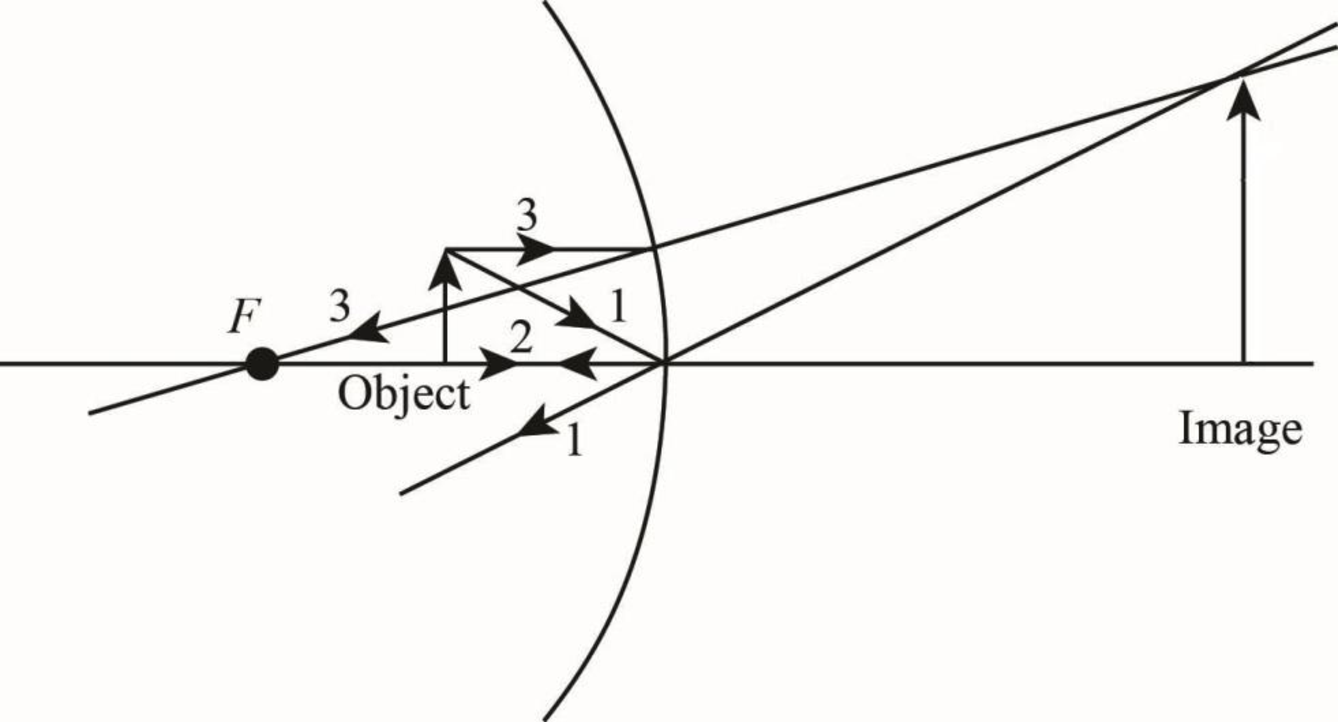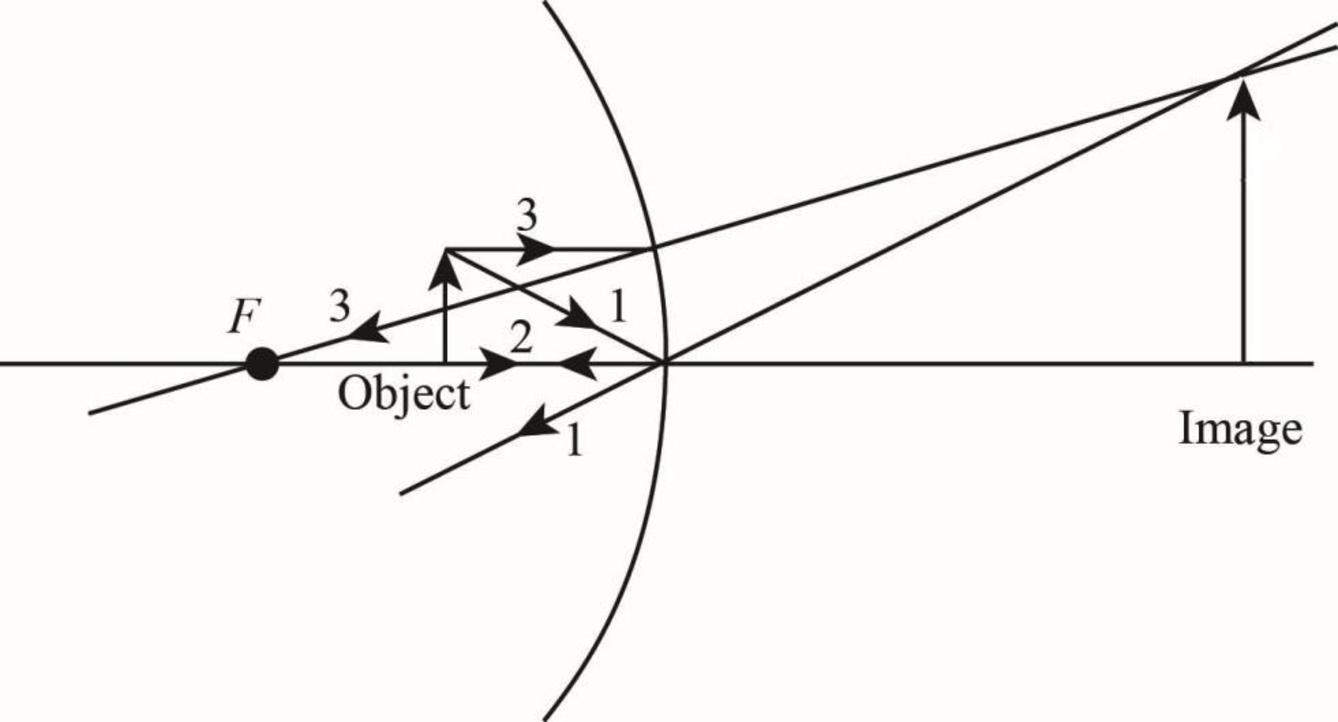
Concept explainers
(a)
The distance of the object from the mirror.
(a)
Answer to Problem 46PQ
The distance of the object from the mirror is
Explanation of Solution
Write the equation for the mirror.
Here,
Rewrite the above expression for
Write the equation for magnification produced by the mirror and find
Here,
Conclusion:
Substitute
Substitute
Therefore, the distance of the object from the mirror is
(b)
Whether the image formed by the mirror is real or virtual.
(b)
Answer to Problem 46PQ
The image distance from the mirror is negative, so the image formed by the mirror is virtual.
Explanation of Solution
Consider equation (III) for the image distance.
Conclusion:
Substitute
Therefore, the image formed at the distance of
(c)
A ray diagram for showing the locations of the object and image.
(c)
Answer to Problem 46PQ
Ray diagram of the object and the image location is shown in the following figure using three rays.

Explanation of Solution
Ray 1 will pass from the top of the object through the vertex of the mirror and reflected opposite to the object position.
Ray 2 will pass from the bottom of the object and reflected back from the mirror on itself.
Ray 3 will pass from the top of the object, which is parallel to the principle axis and reflected through the mirror from the focal point.
The image formed will be virtual and upright.
Therefore, the ray diagram of the object and the image location is shown in figure 1 using three rays.

Figure (1)
Want to see more full solutions like this?
Chapter 37 Solutions
EBK WEBASSIGN FOR KATZ'S PHYSICS FOR SC
- Hi! I need help with these calculations for part i and part k for a physics Diffraction Lab. We used a slit width 0.4 mm to measure our pattern.arrow_forwardExamine the data and % error values in Data Table 3 where the angular displacement of the simple pendulum decreased but the mass of the pendulum bob and the length of the pendulum remained constant. Describe whether or not your data shows that the period of the pendulum depends on the angular displacement of the pendulum bob, to within a reasonable percent error.arrow_forwardIn addition to the anyalysis of the graph, show mathematically that the slope of that line is 2π/√g . Using the slope of your line calculate the value of g and compare it to 9.8.arrow_forward
- An object is placed 24.1 cm to the left of a diverging lens (f = -6.51 cm). A concave mirror (f= 14.8 cm) is placed 30.2 cm to the right of the lens to form an image of the first image formed by the lens. Find the final image distance, measured relative to the mirror. (b) Is the final image real or virtual? (c) Is the final image upright or inverted with respect to the original object?arrow_forwardConcept Simulation 26.4 provides the option of exploring the ray diagram that applies to this problem. The distance between an object and its image formed by a diverging lens is 5.90 cm. The focal length of the lens is -2.60 cm. Find (a) the image distance and (b) the object distance.arrow_forwardPls help ASAParrow_forward
 Physics for Scientists and Engineers: Foundations...PhysicsISBN:9781133939146Author:Katz, Debora M.Publisher:Cengage Learning
Physics for Scientists and Engineers: Foundations...PhysicsISBN:9781133939146Author:Katz, Debora M.Publisher:Cengage Learning Principles of Physics: A Calculus-Based TextPhysicsISBN:9781133104261Author:Raymond A. Serway, John W. JewettPublisher:Cengage Learning
Principles of Physics: A Calculus-Based TextPhysicsISBN:9781133104261Author:Raymond A. Serway, John W. JewettPublisher:Cengage Learning College PhysicsPhysicsISBN:9781305952300Author:Raymond A. Serway, Chris VuillePublisher:Cengage Learning
College PhysicsPhysicsISBN:9781305952300Author:Raymond A. Serway, Chris VuillePublisher:Cengage Learning Physics for Scientists and EngineersPhysicsISBN:9781337553278Author:Raymond A. Serway, John W. JewettPublisher:Cengage Learning
Physics for Scientists and EngineersPhysicsISBN:9781337553278Author:Raymond A. Serway, John W. JewettPublisher:Cengage Learning Physics for Scientists and Engineers with Modern ...PhysicsISBN:9781337553292Author:Raymond A. Serway, John W. JewettPublisher:Cengage Learning
Physics for Scientists and Engineers with Modern ...PhysicsISBN:9781337553292Author:Raymond A. Serway, John W. JewettPublisher:Cengage Learning University Physics Volume 3PhysicsISBN:9781938168185Author:William Moebs, Jeff SannyPublisher:OpenStax
University Physics Volume 3PhysicsISBN:9781938168185Author:William Moebs, Jeff SannyPublisher:OpenStax





